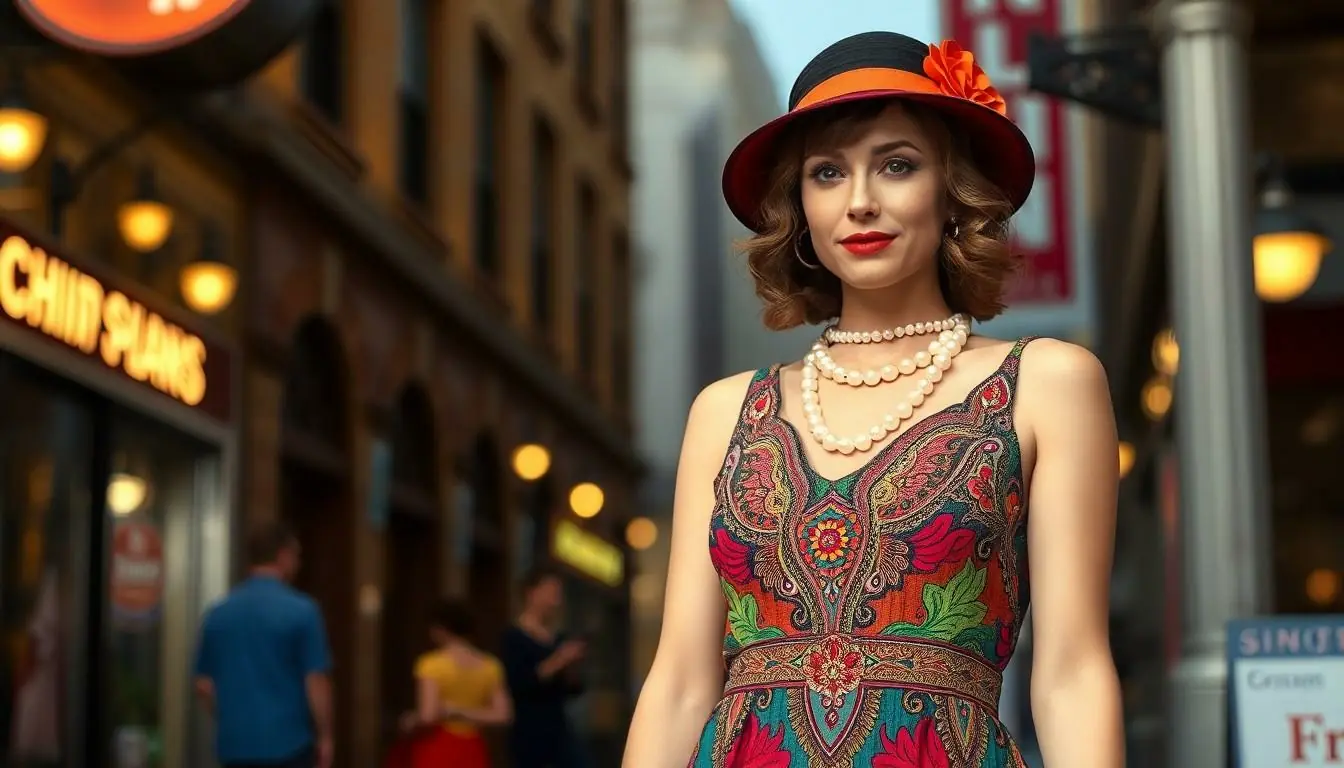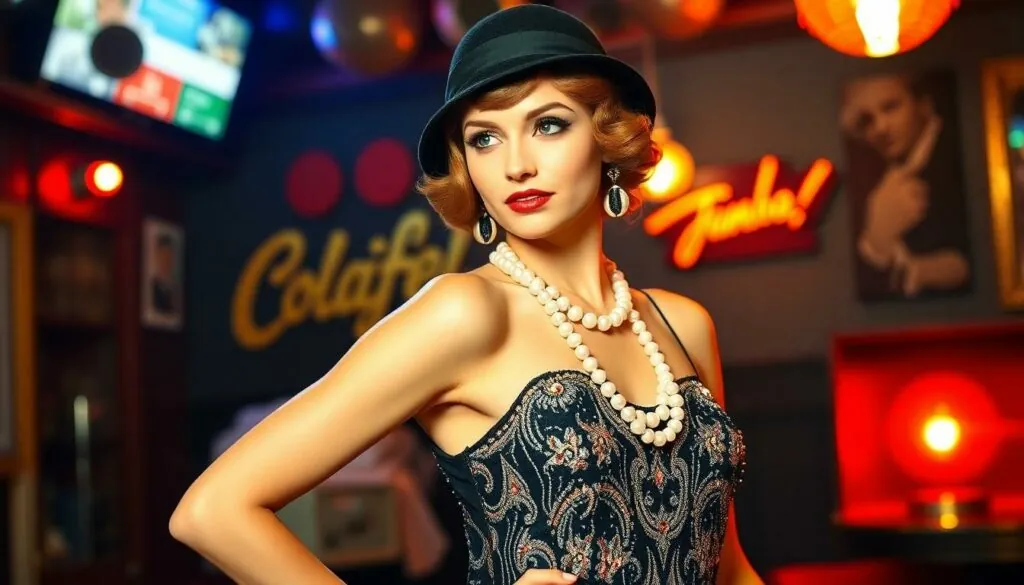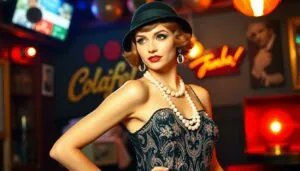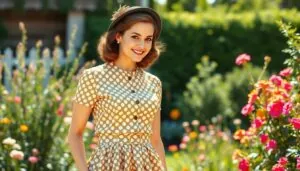Step into a world where flapper dresses twirl and jazz music fills the air—welcome to the Roaring 20s! This dazzling decade transformed women’s fashion, breaking free from the constraints of the past. Picture women confidently donning beaded gowns, bobbed hair, and daring accessories, all while sipping cocktails and dancing the Charleston.
Table of Contents
ToggleOverview of Roaring 20s Women’s Fashion
The Roaring 20s marked a revolutionary shift in women’s fashion, characterized by a sense of liberation and bold creativity. Dresses often featured dropped waists and loose silhouettes, allowing for greater movement. Beaded embellishments and fringe detailing added an element of glamour essential for social gatherings and dances.
Women popularized the flapper style, which defined this decade. Shorter hemlines became fashionable, often reaching just below the knee, breaking previous norms. Fabrics like silk, satin, and rayon were common, providing women with a luxurious feel that complemented their newfound independence.
Accessories played a crucial role in completing outfits. Cloche hats, long strands of pearls, and feathered headbands transformed ensembles. Footwear also evolved, with Mary Jane shoes and T-strap designs becoming iconic for this time.
Hairstyles contributed to the overall aesthetic, with bobbed cuts and finger waves reflecting modernity. Makeup trends emphasized bold lipstick and dark eyeliner, showcasing an attitude of self-expression.
The influence of jazz music and dance clubs drove the demand for more practical yet stylish clothing. Women embraced comfort without sacrificing elegance, embodying the spirit of the era. This fashion movement not only defined a generation but also set the stage for future trends, as women’s fashion continually evolved.
Overall, the Roaring 20s remains a pivotal period, documenting women’s journey toward self-empowerment through fashion.
Key Trends in Roaring 20s Women’s Fashion

The Roaring 20s showcased dynamic trends that transformed women’s fashion, emphasizing personal expression and liberation.
Flapper Dresses and Their Impact
Flapper dresses epitomized the carefree spirit of the 1920s. These dresses featured dropped waists and loose silhouettes, allowing women to dance freely. Shorter hemlines liberated the ankles, defying traditional modesty. Such styles encouraged a sense of youthfulness and independence. Designers like Coco Chanel popularized these iconic pieces, cementing their place in fashion history. Bright colors and intricate beading adorned many designs, emphasizing the glamor of nightlife. The flapper dress became a symbol of the era, representing women’s fight for autonomy and social change.
Accessories and Styling
Accessories played a crucial role in completing the Roaring 20s look. Cloche hats topped off many outfits, providing a chic finishing touch. Long strands of pearls layered around the neck added sophistication, while feathered headbands became a popular choice for embellishment. Mary Jane shoes, with their comfortable design, also gained favor among women. Makeup trends embraced bold colors, with dark eyeliner and red lipstick enhancing the vibrant aesthetic. The combination of these elements created a striking yet cohesive look. Accessories not only complemented outfits but also embodied the era’s spirit of fun and rebellion.
Influential Figures in Roaring 20s Women’s Fashion
The Roaring 20s showcased notable figures who left a significant mark on women’s fashion.
Fashion Icons of the Era
Icons like Clara Bow and Jean Harlow popularized the flapper look. Their daring styles included bobbed hair and loose dresses, embracing the era’s spirit of freedom. Actresses featured in films inspired countless women to adopt a bolder approach to fashion. They encouraged new ideals of beauty through their chic outfits and confident personas. Everyday women sought to emulate these stars, contributing to the widespread adoption of the flapper style.
Designers Who Shaped the Trends
Coco Chanel revolutionized women’s fashion with her innovative designs. She introduced more casual, elegant silhouettes that embodied comfort without sacrificing style. Paul Poiret is another name synonymous with this transformative period. He liberated women from corsets, opting for flowing fabrics and relaxed fits. Their contributions defined what women wore, signaling a departure from conservative Victorian influences. Other designers, like Madeleine Vionnet and Lanvin, also played vital roles in shaping 1920s trends, pushing boundaries with their creative visions.
The Cultural Context of Roaring 20s Women’s Fashion
The Roaring 20s marked a pivotal moment in the evolution of women’s fashion, driven by social and cultural changes.
The Role of Women’s Liberation
Women’s liberation fundamentally altered societal norms during the 1920s. Women pushed back against traditional gender roles, seeking independence and self-expression. The flapper movement emerged as a rallying cry, symbolizing freedom through fashion. Women embraced shorter dresses and looser fits, allowing ease of movement and comfort. This shift represented not just a fashion choice but a rejection of constraints like corsets. Individuality flourished with bold choices in clothing, hairstyles, and accessories. Iconic figures like Coco Chanel championed these styles, promoting the idea that women could dictate their fashion narratives. The liberation movement empowered women to redefine their identities, making the era memorable for its unapologetic embrace of change.
The Influence of Jazz and Dance
Jazz music played a transformative role in shaping women’s fashion during the Roaring 20s. Vibrant jazz clubs became cultural hubs, influencing styles across the nation. Dance styles like the Charleston inspired dress designs that prioritized movement. Flair and fun took precedence, leading to shorter hemlines and daring silhouettes that reflected the joyous spirit of the time. Accessories like long pearl necklaces and feathered headbands complemented these lively outfits, adding glamour. Night life thrived on energy and self-expression, inspiring women to adopt bold fashion statements. The rhythms of jazz fostered a lively atmosphere where carefree styles became the norm, intertwining music with the dynamic fabric of 1920s fashion.
The Roaring 20s was a defining era for women’s fashion that celebrated freedom and individuality. With bold styles and innovative designs women transformed their wardrobes and their identities. The flapper movement not only redefined fashion but also empowered women to break free from traditional constraints.
As jazz music filled the air and cultural norms shifted women embraced a new sense of self-expression. The influence of iconic designers and fashion figures left a lasting legacy that continues to inspire modern fashion. The vibrant spirit of the 1920s remains a testament to the power of style in shaping societal change and personal identity.




